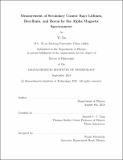Measurement of secondary cosmic rays lithium, beryllium, and boron by the alpha magnetic spectrometer
Author(s)
Jia, Yi, Ph. D. Massachusetts Institute of Technology
DownloadFull printable version (14.50Mb)
Other Contributors
Massachusetts Institute of Technology. Department of Physics.
Advisor
Samuel C. C. Ting.
Terms of use
Metadata
Show full item recordAbstract
Secondary cosmic rays are mainly produced by the collisions of nuclei with the interstellar medium. The precise knowledge of secondary cosmic rays is important to understand the origin and propagation of cosmic rays in the Galaxy. In this thesis, my work on the precision measurement of secondary cosmic rays Li, Be, and B in the rigidity (momentum/charge) range 1.9 GV to 3.3 TV with a total of 5.4 million nuclei collected by AMS is presented. The total error on each of the fluxes is 3%-4% at 100 GV, which is an improvement of more than a factor of 10 compared to previous measurements. Unexpectedly, the results show above 30 GV, these three fluxes have identical rigidity dependence and harden identically above 200 GV. In addition, my work on a new method of the tracker charge measurement leads to significant improvements in the AMS charge resolution, thus paving the way for the unexplored flux measurements of high Z cosmic rays.
Description
Thesis: Ph. D., Massachusetts Institute of Technology, Department of Physics, 2018. This electronic version was submitted by the student author. The certified thesis is available in the Institute Archives and Special Collections. Cataloged from PDF version of thesis. Includes bibliographical references (pages 113-122).
Date issued
2018Department
Massachusetts Institute of Technology. Department of PhysicsPublisher
Massachusetts Institute of Technology
Keywords
Physics.